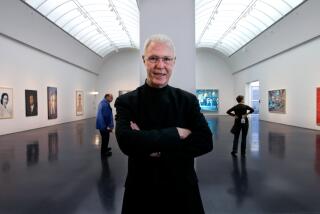Seeing the Light : Scientist Creates O.C. Company That Uses Lasers to Test Products
- Share via
TUSTIN — It doesn’t take a rocket scientist to know that lasers are leading-edge technology. But it does take one to know just how they can be used--and that’s where Colleen Fitzpatrick comes in.
Fitzpatrick, a nuclear physicist, spends her days hunched over brilliant, pencil-thin beams of red light that carom across a large table. There, she can use lasers to test various products--anything from a stereo speaker to microcircuits--to see how the products hold up under various temperatures and pressures.
The process is called holography--the same technique that creates those eye-popping, three-dimensional artistic images that grace museum walls and credit cards. By splitting the light from a laser, Fitzpatrick can compare images in the two beams to measure the minute differences in an object over a period of seconds.
“It’s a combination of science and art,” said the 38-year-old scientist. “There’s even some people who think the brain works holographically.”
Fitzpatrick runs her own consulting company, Electro-Optic Consulting Services, from a small laboratory in Tustin. It is a one-woman outfit that performs laser diagnostics for such government clients as the Department of Health and Human Services, the Air Force and the Defense Advanced Research Projects Agency, and a few private companies as well. She made an exploratory marketing trip to China last year.
Fitzpatrick, who estimates that her business will gross more than $100,000 this year, wants to expand, hire a few employees and take laser holography to the next stage. For now, though, she alternates between sales trips and the laboratory, a dual role she says she does not mind.
“I like people,” Fitzpatrick says. “I’m more people-oriented than a lot of scientists.”
How many scientists can boast of having appeared as a contestant on the syndicated television game show “Jeopardy!”? Fitzpatrick can. With a doctorate in nuclear physics from Duke University, Fitzpatrick notes that she aced the science categories but was felled by French literature and placed second to a shirt salesman. She won a sofa bed and a washing machine.
Her interest in holography developed when she was teaching physics at Sam Houston State University in Huntsville, Tex., a decade ago. Another teacher had a holography setup to use for teaching, but he was on leave and no one was using it. It was an open invitation for Fitzpatrick to start tinkering.
No matter how hard she tried, the holograms did not look right because the lasers were not aligned precisely enough. Just when she was ready to give up, a holographic expert, T.H. Jeong of Lake Forest College in Lake Forest, Ill., gave a presentation in which he created a holographic image before an audience of 1,000. Fitzpatrick figured that if he could do it, she could too.
She left the university in 1984 to take a job at Rockwell International in Seal Beach working on lasers and related projects. Among them was an experiment in the joint use of lasers and radar in support of the Strategic Defense Initiative, the proposed space-based missile shield better known as “Star Wars.”
She left Rockwell in 1987, just as the defense industry was beginning to slow, and came to work at Spectron Development Labs in Costa Mesa, a laser diagnostics company. She worked there as a specialist in holography until 1989, when a layoff prompted her to begin consulting. Initially, she worked out of her Fountain Valley garage. Recently, however, she returned to Spectron--now Titan/Spectron, under new management and relocated to Tustin--where she rents lab space.
The work is not as flashy as it might sound. Instead of 3-D images dancing before her nose, Fitzpatrick is more likely to see an object as a fuzzy red outline. A laptop computer measures changes in the object by the second whenever conditions are changed, as when pressure is applied.
Small industrial testing jobs help pay the bills while Fitzpatrick looks toward more involved holographic research. New uses for holography are being invented all the time, she said, and the process itself is evolving. Research has produced, for example, a new kind of film for recording a holographic image that uses chemicals derived from bacteria instead of conventional photographic materials. Because the bacteria-derived chemicals react to light, the film is reusable--and potentially could save thousands of dollars during an experiment.
The business side of consulting did not come as naturally to Fitzpatrick as the scientific side. Fitzpatrick said she had to learn how to price her work, and how to write proposals for government research funds.
“People don’t understand the level of effort you put into these proposals,” she said.
But for that matter, most people don’t know the first thing about lasers, either.
Profile: Colleen Fitzpatrick
President and owner: Electro Optic Consulting Services
Credentials: Master of science and Ph.D. in nuclear physics, Duke University, 1983.
Background: Principal investigator at Spectron Development Labs for the NASA LITE laser, the first laser used on the space shuttle. Also involved in the application of holographic cameras, wind tunnel holography and the use of lasers to detect damage in structures such as bridges.
Honor: American Academy of Achievement Award, 1991
Source: Electro Optic Consulting Services
More to Read
Inside the business of entertainment
The Wide Shot brings you news, analysis and insights on everything from streaming wars to production — and what it all means for the future.
You may occasionally receive promotional content from the Los Angeles Times.









